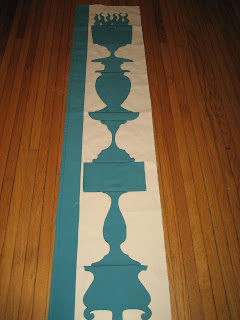Lately I've been obsessively working on a pavilion. Make that a
Pavilion!
In my fantasies it is all gloriously banded, appliqued and embroidered; it has mottoes and banners and a heraldic full inner liner based on our devices; it's fully furnished--in period appropriate furniture, of course--and makes quite a splash at events. (Ah, vanity, your name is Aurora...)
Of course, what I have right now is a rather large and heavy pile of chunks of fabric in various stages of construction. And pictures. I have pictures!
(Oh, and I also have very sore hands which are slowly forming pavilion-making-callouses, thank goodness!)
 My doorway panels: In progress
My doorway panels: In progressAnyway, long, long ago in a land far, far away (2000-ish in Northern California) I started reading about the SCA on the internet and formed a desire to a) go to Pennsic, b) make a pavilion, and c) uphold my belief that the stripes and other decorations on period tents were more likely sewn than painted by doing just that. On to e-bay for canvas and I was shortly the proud owner of about 60 yards of flame retardant canvas in a lovely off-white and another chunk of canvas in a lovely blue-green and so I started work cutting 8 1/5' long oblongs of canvas into 2 triangles, attaching a band of the blue-green to the cut edge for support (thus making those colored stripes I saw on period illustrations) and assembling the triangles together.
Which worked just great until I tried to sew two of my assembled pairs of triangles together and discovered that my machine *really* didn't like trying to make 3 flat-felled seams in the same place. Hmmmm....
Now I know why people use semi-circles at the very tip.
Of course, I then decided that I wasn't sure what style/size of pavilion I wanted...or how I was going to make those roof panels work...and I've been carting around around a partially finished tent ever since!
****
This winter seems to be the year of the pavilion.
I've decided to convert the pieces I originally made for the roof of a circular single pole pavilion into the cone-shaped end pieces of a double belled wedge. the finished wedge is going to be about 10' tall so I'm going to have to add additional length to the original pieces. I still haven't figured out how I am going to do *that* so right now I'm working on the center section.
It will be a panel which is 11' high by 9' wide (finished dimensions) on each side. The bottom section of each side will have a 7' high by 6' wide doorway opening bordered by 7' high x1 1/5' wide panels. they will connect to an 1' high by 9, wide panel which forms the top of the doorway, which will connect to a 8' x 9' day shade flap and the remaining 3'high by 9' wide roof piece.
I hope that description makes sense, but it will all be clear in the photos as it starts coming together.
Which brings me to the pictures!
Inspired by many lovely examples of late-period ornamentation I am going for a highly-embellished pavilion. the pilasters on each side of the doorway seemed a natural place for such embellishment and accommodate the candelabrum form well. There will need to be four such panels so,
naturally, I am making a panel for each of the four elements. You can see all four panels in their various stages of applique above.
I've finished stitching down the entire "fire" panel and am well on the way with "water" but, as you can see, the other two elements are still in the thinking stages. The fire panel took me a week (hand stitching) so if I can keep up the pace I could have all 4 attached by the end of February. Wish me luck!
I'm pretty sure that they will need additional embroidery to add detailing and make them look less modern. One thing at a time.
 This is a detail of the Fire panel. you can see I still need to remove all the stay-stitching from the pieces
This is a detail of the Fire panel. you can see I still need to remove all the stay-stitching from the pieces




































